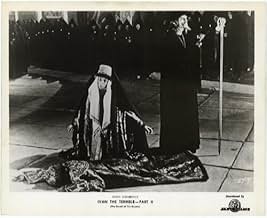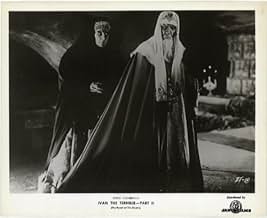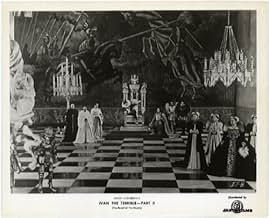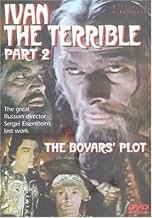VALUTAZIONE IMDb
7,7/10
8463
LA TUA VALUTAZIONE
Aggiungi una trama nella tua linguaAs Ivan the Terrible attempts to consolidate his power by establishing a personal army, his political rivals, the Russian boyars, plot to assassinate their Tsar.As Ivan the Terrible attempts to consolidate his power by establishing a personal army, his political rivals, the Russian boyars, plot to assassinate their Tsar.As Ivan the Terrible attempts to consolidate his power by establishing a personal army, his political rivals, the Russian boyars, plot to assassinate their Tsar.
- Regia
- Sceneggiatura
- Star
- Premi
- 1 candidatura in totale
Vsevolod Pudovkin
- Nikolay the Fanatic
- (as V.I. Pudovkin)
Ada Voytsik
- Elena Glinskaya, Ivan's Mother
- (as Ada Vojtsik)
Aleksandr Rumnev
- The Stranger
- (non citato nei titoli originali)
Semyon Timoshenko
- Kaspar von Oldenbock, Livonian ambassador
- (non citato nei titoli originali)
Recensioni in evidenza
Ivan the Terrible Part II, the culmination of Eisenstein's career, is easily one of the most brilliant films of all time.
Nothing - repeat absolutely nothing - in this film is sub-par. The acting, especially the inhuman physical contortions of Nikolai Cherkasov as the Tsar himself, is uniformly excellent. As is to be expected from Eisenstein, the direction is perfect. Eisenstein's compositions create painterly tableaux that can be watched endlessly on pause (especially now that Criterion has issued both Ivans on DVD), allowing the audience to take in the full breadth of this man's genius. Additionally, unlike, for example, Alexander Nevsky or Strike, Ivan the Terrible Part II (and part I) benefits from a smoother pace and better editing, putting Eisenstein's theory of montage to its best use since Potemkin.
For me, however, what two key components of this film set it apart from its prequel and Eisenstein's earlier Potemkin and October.
Those components, as you can imagine, are its more pronounce political allegory and its color sequence towards the end.
Certainly October and Potemkin were highly politicized affairs, both celebrating the Communist victory in Russia. In Ivan the Terrible Part II (and to a lesser extent Part I), the audience bears witness to a moment of challenge wherein Eisenstein becomes critical of the course his country and its post-Lenin leaders have taken. As such, Ivan the Terrible becomes one of the bravest moments in film history and, for that alone, should be commended.
Brilliant as a political critique, the film also represents a dazzling demonstration of how color could be used in cinema. The colorized dance at the end of the film rivals and prefigures the technicolor explosion in Douglas Sirk's 1950s melodramas; furthermore, it reveals that color can be used to achieve specific effects. It does not have to mimic reality; rather it can be used artistically to enhance the mood and atmosphere of the film.
Taken as a whole, the two-part Ivan the Terrible is a masterpiece of Russian Cinema and should be required viewing for anyone with the slightest bit of interest in film. My preference lies with the second part, but both are fantastic moments in film history.
Nothing - repeat absolutely nothing - in this film is sub-par. The acting, especially the inhuman physical contortions of Nikolai Cherkasov as the Tsar himself, is uniformly excellent. As is to be expected from Eisenstein, the direction is perfect. Eisenstein's compositions create painterly tableaux that can be watched endlessly on pause (especially now that Criterion has issued both Ivans on DVD), allowing the audience to take in the full breadth of this man's genius. Additionally, unlike, for example, Alexander Nevsky or Strike, Ivan the Terrible Part II (and part I) benefits from a smoother pace and better editing, putting Eisenstein's theory of montage to its best use since Potemkin.
For me, however, what two key components of this film set it apart from its prequel and Eisenstein's earlier Potemkin and October.
Those components, as you can imagine, are its more pronounce political allegory and its color sequence towards the end.
Certainly October and Potemkin were highly politicized affairs, both celebrating the Communist victory in Russia. In Ivan the Terrible Part II (and to a lesser extent Part I), the audience bears witness to a moment of challenge wherein Eisenstein becomes critical of the course his country and its post-Lenin leaders have taken. As such, Ivan the Terrible becomes one of the bravest moments in film history and, for that alone, should be commended.
Brilliant as a political critique, the film also represents a dazzling demonstration of how color could be used in cinema. The colorized dance at the end of the film rivals and prefigures the technicolor explosion in Douglas Sirk's 1950s melodramas; furthermore, it reveals that color can be used to achieve specific effects. It does not have to mimic reality; rather it can be used artistically to enhance the mood and atmosphere of the film.
Taken as a whole, the two-part Ivan the Terrible is a masterpiece of Russian Cinema and should be required viewing for anyone with the slightest bit of interest in film. My preference lies with the second part, but both are fantastic moments in film history.
Ivan Grosnyy, Part II is the movie of my life; the Part I is also a very good film. It is the masterpiece of Sergei Eisenstein. Unfortunately we can never see the Part III of this meant to be trilogy. The performances (especially Nikolai Cherkasov), the photography, the wardrobe, the scenarios and the shots are the most beautiful I have ever seen in the history of film-making. However, it is necessary to watch the Part I first to understand the history. I suggest to all the people who like this genre of film to see another very good film of Sergey Eisenstein: Alexander Nevsky once again with Nikolai Cherkasov in the main role. I recommend to all the people who want to see these movies to by the Criterion DVD box set, which contains also first part and, Alexander Nevsky. Don't die without seeing these masterpieces.
This second part of Eisenstein's history of the reign of "Ivan the Terrible" is an excellent portrayal of the complex machinations between the famous tsar and his determined rivals, the boyars. The story, the settings, the actors, and the characters surpass even the high standards of Part One. Nikolai Cherkasov is again excellent in his portrayal of Ivan, with even his occasional exaggerations fitting nicely into his memorable characterization of the formidable tsar. Serafima Birman is again quite effective as Ivan's aunt and most bitter rival. As Vladimir, Pavel Kadochnikov gets much more to do than he did in Part One, and he makes good use of his scenes. The character of Vladimir - foolish and timid, but with ambition in his heart - is important to the way that events play out.
The story in Part Two picks up at a low point for Ivan, finding him with few friends and many problems. As the boyars begin to plot, there is less outward action than there was in Part One, but the drama is even tauter and the stakes even higher. The picture is also rounded out by the flashbacks to Ivan's youth, which give an even more complete picture of this complex ruler. (The English nickname 'terrible' does not really convey the full sense of his actual nickname in Russian.)
The early scenes lead up to the lengthy sequence of the banquet and its aftermath, which a masterpiece of psychological drama and effective film-making. The cat-and-mouse game between Ivan and his enemies is complemented by the color, imagery, and other details, and it all leads up to a climax filled with tension and possibilities.
Eisenstein's series on Ivan showcases the great Russian director's distinctive technique, and it is certainly one of the finest of all historically-based movies. With memorable characters, interesting stories, and lots of creativity, both movies are well worth multiple viewings - and this second part is even better than the first.
The story in Part Two picks up at a low point for Ivan, finding him with few friends and many problems. As the boyars begin to plot, there is less outward action than there was in Part One, but the drama is even tauter and the stakes even higher. The picture is also rounded out by the flashbacks to Ivan's youth, which give an even more complete picture of this complex ruler. (The English nickname 'terrible' does not really convey the full sense of his actual nickname in Russian.)
The early scenes lead up to the lengthy sequence of the banquet and its aftermath, which a masterpiece of psychological drama and effective film-making. The cat-and-mouse game between Ivan and his enemies is complemented by the color, imagery, and other details, and it all leads up to a climax filled with tension and possibilities.
Eisenstein's series on Ivan showcases the great Russian director's distinctive technique, and it is certainly one of the finest of all historically-based movies. With memorable characters, interesting stories, and lots of creativity, both movies are well worth multiple viewings - and this second part is even better than the first.
While the first part of "Ivan the Terrible" is unique, stylized and powerful historical chronicle, second part is something more: poignant tragedy of authority. Since boyars poisoned Ivan's wife and his friends betrayed him, tsar remains in lonely. Oprichniki are only people he can trust. Ivan orders to kill some of boyars for instance, then Efrosinia Staricka (his aunt) sets plot against his life. One word gives atmosphere of this film: paranoia. Every character cares burden of fear - about his life, about his political business. Pervasive fear is delivered to us with unearthly dance of shadows, dramatic Prokofiev's score, haunting acting, poetic dialogs, monumental decorations and costumes. Everything looks very artificial but, paradoxically, not false; this film works with peerless emotional strength and brings as much true about authority as Shespeare's best works, being compatible to Maciavlelian theory of authority. There are only few films in history of cinema that so heavily consider problems of power (I'd mention "The Godfather, Part II" and Kurosawa's "Kagemusha" and "Ran" beside "Boyars Plot"). Don't miss. And if you decide to watch this film, I recommend: take great Criterion DVD box set which contains also first part and "Alexander Nevsky", another Eisenstein's sound masterpiece.
In 1564, Ivan, The Terrible (Nicolai Cherkasov), is feeling alone: his wife, friend and great companion was poisoned and his best friend, Prince Andreu Kurbsky (Mikhail Nazvanov) has betrayed him and delivered some Russian cities to Poland. Trying to have somebody to believe, he promotes Archbishop Philip (Andrei Abrikosov) to the highest authority of the church in the city of Moscow. Then, the story presents lot of treason in his court and a great revenge. This movie is so remarkable as `Part I' is. The photography, lights and shadows in black and white are again a piece of art. There are at least twenty minutes in color, and in my opinion t would be better off being only in black and white. The sumptuous scenarios are amazing, plenty of details and very luxury, and the story is a sequel of an epic. The direction and the performance of the cast are outstanding, making this movie another unforgettable masterpiece and highly recommended. However, it is necessary to watch the `Part I' first, otherwise the viewer will not understand the story. My vote is ten.
Lo sapevi?
- QuizThis film was withheld by Soviet authorities by order of Joseph Stalin, since this film, dealing with Ivan's slide into madness and the tyranny of the Oprichnina, did not properly mythologize Ivan IV Grozny to Stalin's satisfaction. It was not finally released until 10 years after the deaths of director Sergei Eisenstein and Stalin.
- BlooperIn the movie young Ivan IV is making a contract with the Livonian Brothers of the Sword. However it didn't exist since the 7th June 1238, almost 300 years before Ivan was born.
- Citazioni
Czar Ivan IV: From now on I will become the one you call me. I will become terrible.
- Curiosità sui creditiThe main cast and their roles is read by the narrator with accompanied footage.
- ConnessioniFeatured in The Secret Life of Sergei Eisenstein (1987)
I più visti
Accedi per valutare e creare un elenco di titoli salvati per ottenere consigli personalizzati
Dettagli
- Data di uscita
- Paese di origine
- Lingua
- Celebre anche come
- Ivan the Terrible, Part II: The Boyars' Plot
- Luoghi delle riprese
- Aziende produttrici
- Vedi altri crediti dell’azienda su IMDbPro
Botteghino
- Lordo in tutto il mondo
- 1655 USD
- Tempo di esecuzione1 ora 28 minuti
- Colore
- Mix di suoni
- Proporzioni
- 1.37 : 1
Contribuisci a questa pagina
Suggerisci una modifica o aggiungi i contenuti mancanti

Divario superiore
By what name was La congiura dei boiardi (1946) officially released in India in English?
Rispondi
































